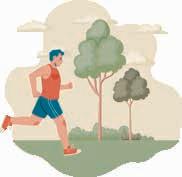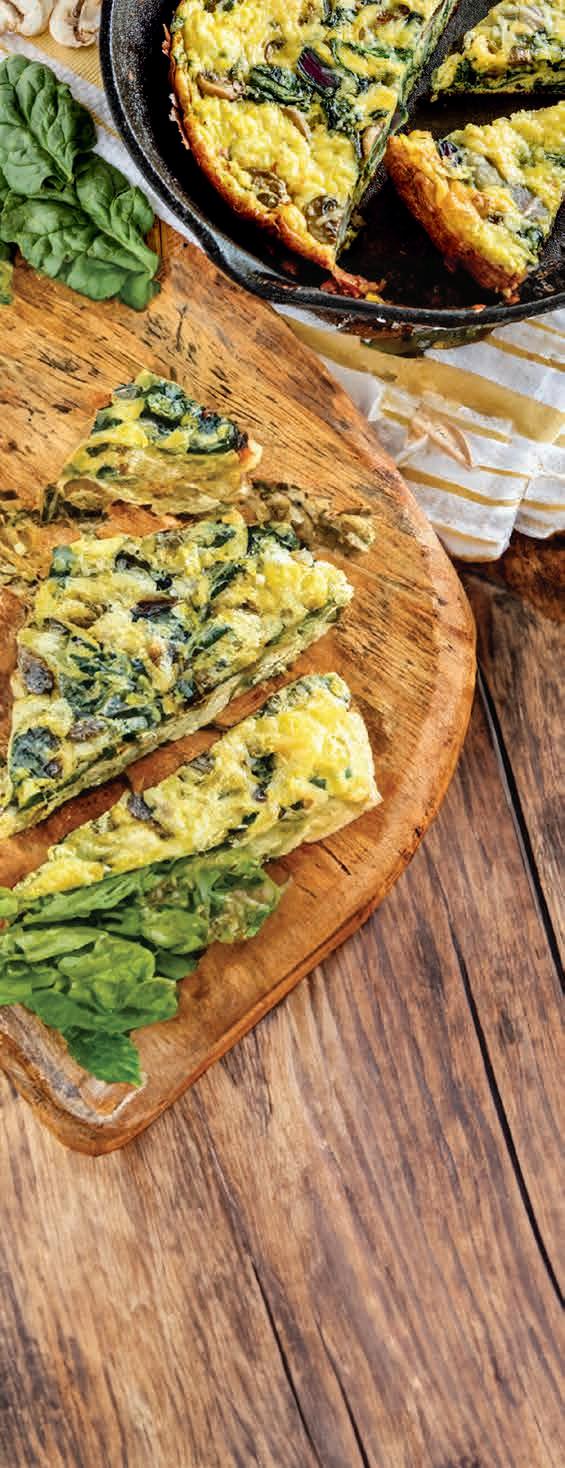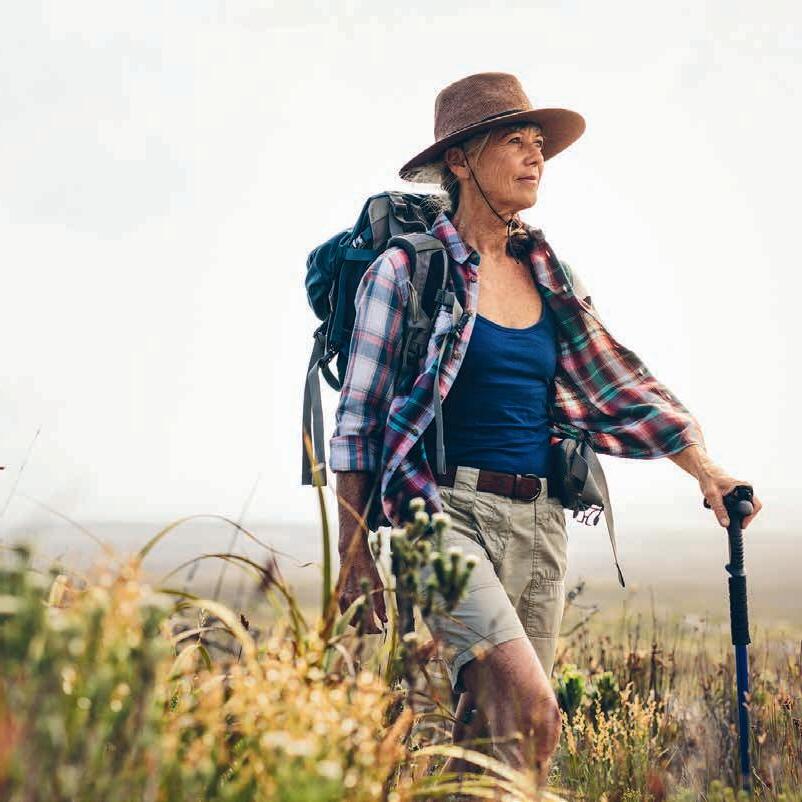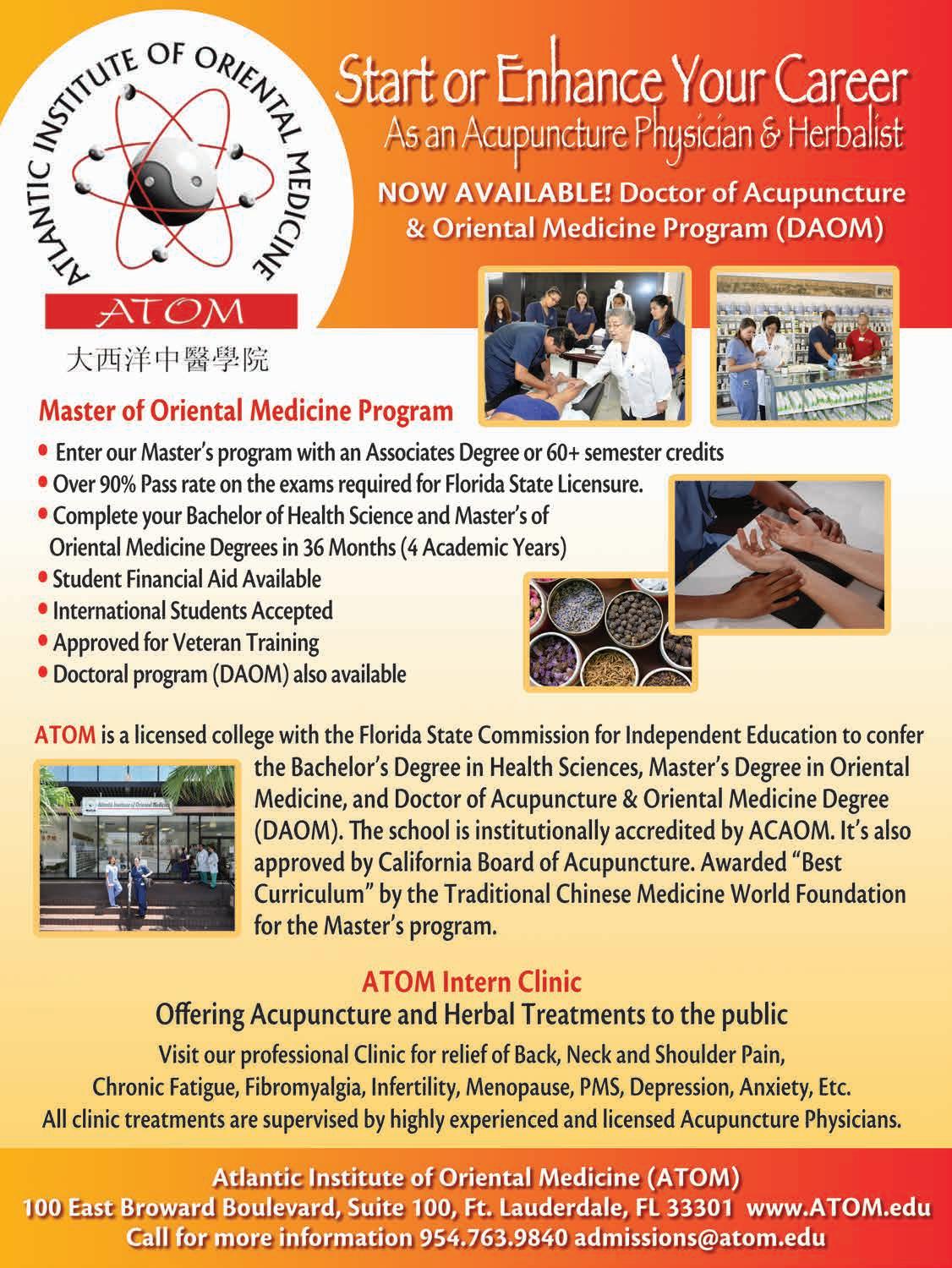

The
UNDERSTANDING
Safe and Fun Hikes for EVERY AGE



The
UNDERSTANDING
Safe and Fun Hikes for EVERY AGE

DISCOVER a perfume that embodies the beauty of unity and celebrates global wellness. Oneness Sport is more than a fragrance; it's a statement of peace and harmony. Crafted for both men and women, this unisex sensation is recommended for personal ceremonies and special occasions like weddings, engagements, romantic commitments, and anniversaries.










April’s feature story is Sustainable Travel (page 16), advocating for ecoconscious exploration, aiming to mitigate the 8.1 percent of global greenhouse gas emissions generated by tourism. The author suggests prioritizing less touristy destinations and using sustainable transportation. Read tips on packing eco-friendly essentials and supporting local economies, underscoring the significance of individual choices in reducing environmental impact.

As consumption patterns outpace the Earth’s ability to replenish resources, the urgency of actions that support global environmental stewardship is ever more important.
The Heal-OurWorld Checklist (page 8) offers practical steps toward sustainable living, from mindful consumption to energy efficiency, and community engagement, fostering hope for our planet’s future.
NaturalAwakeningsFla@gmail.com
Publisher
Design
Relief for Parkinson’s Patients (page 14) delves into strategies beyond pharmaceuticals to manage symptoms and improve quality of life for patients affected by Parkinson’s disease. Insights from medical professionals illuminate complementary interventions like exercise regimens, dietary adjustments, and stressreduction techniques. These resources are shared to offer support for both patients and caregivers.
A Look at Single-Use Plastics (page 10) outlines the environmental and health hazards posed by the global use of singleuse plastics, which contribute significantly to pollution and endanger both humans and wildlife. Efforts to ban or tax these plastics can be thwarted and effective recycling remains elusive due to contamination issues. Exploring alternatives and reevaluating consumption habits are crucial steps in mitigating the environmental impact of single-use plastics.

Farm Vacations, American Agritourism Grows in Post-Pandemic Times (page 12) celebrates the flourishing of agritourism in the United States, offering city dwellers an opportunity to reconnect with rural life while supporting small-scale farms. Through educational and experiential offerings, agritourism promotes sustainability and redefines the relationship between farmers and consumers in a mutually beneficial manner.
Positive contributions to the planet and communities happen through individual and group engagement, fostering a brighter, more sustainable future for all.
“We can improve soil health much faster than we used to think. It’s just a matter of following the principles of nature.”
~ Gabe Brown
 Susan Q Wood Publisher
Susan Q Wood Publisher
Yearly
Copy
CEO
NaturalAwakenings@KnoWEwell.com
Cover
Shutterstock

Natural




Due
Submit
Login/Join
A radical new approach to managing Type 2 diabetes developed by Daniel J. Cox, Ph.D., from UVA Health, has received $3.5 million in funding from the National Institutes of Health for a large-scale clinical trial. The approach focuses on educating individuals about making wise dietary and exercise choices to control blood sugar and potentially alter the course of the disease. Rather than prioritizing weight loss or medication, it aims to reduce post-meal blood glucose levels, which are linked to cardiovascular risk and high levels of AIC, a marker of blood sugar over time.
Known as Glucose Everyday Matters (GEM), the approach combines educated food and drink selections with physical activity to prevent blood sugar spikes and hasten recovery if they occur. A small, initial trial involving 17 recently diagnosed adults with Type 2 diabetes showed promise, with 67 percent achieving remission after three months, and only one participant requiring medication. This trial was the first testing of self-administration instead of faceto-face delivery by medical providers.
This research offers promising hope for managing Type 2 diabetes through lifestyle interventions, providing patients with new options for controlling and potentially achieving remission from the disease. Cox’s personal success with the approach, maintaining consistently low A1C levels without medication for the past 13 years, further supports its potential.

According to a randomized clinical trial published in JAMA Psychiatry, mindfulness-based stress reduction (MBSR) has been found to be a well-tolerated treatment option that can be as effective as commonly prescribed anxiety medications. The study involved 276 adults with diagnosed anxiety disorders that were randomly assigned to either an eight-week MBSR course or treatment with escitalopram, a first-line anxiety medication. Anxiety levels were assessed using the Clinical Global Impression of Severity scale (CGI-S).
At the end of the study, both the MBSR and escitalopram groups experienced a reduction in their mean CGIS score, with no significant difference between the two groups. MBSR was well-tolerated, with no dropouts due to adverse events, whereas a higher percentage of participants in the escitalopram group reported adverse events. The results demonstrated that MBSR was not inferior to escitalopram in reducing anxiety symptoms.
An estimated 301 million people worldwide are affected by anxiety disorders, including generalized anxiety, social anxiety, panic and agoraphobia, causing significant distress, impaired functioning and elevated risk of suicide.


According to a 2023 study by Yale scientists published in the journal Nature Neuroscience, two distinct neurodevelopmental abnormalities that arise shortly after the start of brain development have been linked to the emergence of autism spectrum disorder (ASD). The researchers created brain organoids using stem cells from 13 boys with the disorder, including eight with macrocephaly, a condition in which the head is enlarged. The organoids were small replicas of developing brains that mimicked neuronal growth in the fetus.
The study found that children with ASD and macrocephaly showed an excessive growth of excitatory neurons, while those without macrocephaly exhibited a deficit of the same type of neurons. Measuring the prevalence of certain types of neurons, as was done in this study, could help doctors diagnose autism and also identify which autism cases might benefit from existing drugs that treat excessive excitatory neuron activity.


On April 8, millions of Americans along a 100-mile-wide path across 13 states from Texas to Maine will have an opportunity to witness a total solar eclipse. Thanks to a team from the Harvard University Astronomy Lab, people with visual impairments will be able to experience the celestial event, too, thanks to a smartphone-sized device called LightSound, which translates ambient brightness into sound.
Users of the LightSound device will hear a piping flute for daylight that will transition to a clarinet as the light dims when the moon passes in between the Earth and sun. As the eclipse reaches its zenith, LightSound will emit soft clicks to represent total darkness. The device is designed to complement the multi-sensory event, which may include a drop in temperature and the sounds of nighttime creatures like crickets and owls.
To make astronomy more inclusive, the Harvard team plans to distribute more than 700 LightSound devices at no cost. In addition, the device and its code are open-source so those with the skills can make their own. To learn more, visit Astrolab.fas. Harvard.edu/LightSound.html.
Scientists at the BioRescue project have announced a breakthrough in embryo transfer that could save the northern white rhinoceros from extinction. According to the World Wildlife Federation, two genetically different subspecies exist—the northern and southern white rhino—found in two different regions of Africa. There are only two northern white rhinos left, both of which are female, living under protected housing in Kenya.
The BioRescue team achieved the world’s first rhino pregnancy through in vitro fertilization by implanting a southern white rhino embryo in a surrogate mother named Curra. Although the surrogate mother died after two months due to an unrelated infection, the successful embryo transfer offers proof of concept that this strategy could help save the northern white rhinos.
Plans are underway to implant a northern white rhino embryo into a southern white rhino surrogate mother. The scientists have used preserved sperm and eggs from the remaining females to make 30 preserved embryos. The BioRescue project has cost millions of dollars, supported by public and private donors. Eventually, the group hopes to reintroduce northern white rhinos into the wild.
Our current systems and practices are depleting the Earth’s resources at an increasing rate well beyond its capacity to renew itself. According to the World Wildlife Fund, it takes a year-anda-half to generate the resources we use in one year. That’s an unsustainable path for the planet’s future.
The world needs topsoil to grow 95 percent of its food, and yet the United Nations Food and Agriculture Organization estimated in 2019 that 90 percent of the Earth’s topsoil is likely to be at risk by 2050.
Such statistics seem daunting, but if each of us reduces their individual ecological footprint, together we can make a difference. Here is an action checklist. Consult it often and complete one action at a time. Think of incremental change as hope.
■ Plant a produce garden for homegrown sustenance.
■ Build a compost bin in the yard.
■ Shop at local farms and farmers markets.
■ Join a community-supported agriculture group.
■ Eat a meatless meal at least once a week.
■ Recycle paper, cardboard, plastic, glass and metals.
■ Use reusable water bottles.
■ Shop with reusable bags.
■ Buy organic and regenerative organic foods.
■ Buy local, sustainably sourced and packaged products.
■ Choose products with less packaging to reduce waste.
■ Take fewer and shorter showers.
■ Run the dishwasher only when it is full.
■ Fix leaks throughout the house.
■ Buy natural-fabric clothing; avoid synthetic garments.
■ Wash clothes in larger loads, on shorter cycles and in cold water; add a filter to absorb most microfibers.
■ Wash the car less often.
■ Avoid watering the lawn or power washing the home and walkways.
■ Set up a rain barrel to catch water for the garden.
■ Plant drought-tolerant plants.
■ Walk, bike and take public transportation over driving.
■ Drive a small car; turn off the engine when idling more than 30 seconds.

■ Regularly service the car; change air filters, fill tires and maintain emission control systems.
■ Avoid short airplane trips; take a bus or train instead.
■ Choose energy-saving light bulbs and appliances.
■ Insulate walls, windows and ceilings.
■ Consider double-paned windows.
■ Keep thermostat low in winter and high in summer and strategically open windows.
■ Unplug electronics when not in use.
■ Hang-dry clothes.
■ Choose sustainably produced, nontoxic furniture.
■ Use biodegradable, nontoxic cleaning products.
• Earth Overshoot Day, when humanity exhausts nature’s budget for the year, and how to #MoveTheDate at EarthOvershootDay.org.
• The personal footprint calculator at FootprintCalculator.org.
• Rodale Institute’s organic-growing resources at RodaleInstitute.org.

Each April, Mother Nature spills blossoms from her apron as songbirds trill the songs of their ancestors and prepare for the next generation. Contrary to widespread human assumption, many animal species grieve, express empathy and form bonds that still elude our complete understanding. Trees communicate through complex root systems. Plants respond to environmental and emotional stimuli. Wolves howl their soul-song, and
particles of desert sand emit bell-like frequencies if the wind’s provocation is just right. Our planet is alive on levels beyond our senses or scientific instruments.
To the ancient Greeks, Gaia (also known as Gaea) was a living being separate from the gods that ruled the Earth—a primordial, maternal entity from which all life springs. Through the centuries, luminaries such as Plato or 1970s scientist James Lovelock
have endeavored to define this life force, but perhaps 12th-century abbess and visionary Hildegard von Bingen came closest when she coined the word veriditas to denote “the greening power of nature”. Whether we see this innate energy as simple photosynthesis or handiwork of a higher power, sentient Earth is our all-providing, intelligent resource from cradle to grave.
Many of us can remember a moment in childhood when nature startled our consciousness, be it in a drop of pond water under a microscope or in the shocking power of a summer thunderstorm. We ran barefoot over her grassy lap, made wishes on stars and boggled our minds trying to grasp the concept of light years. This intimate relationship with the planet and her cosmic connections may dwindle in adulthood, but something deep within our souls—if we are honest with ourselves— longs to reunite with anima, Earth’s everpresent, pervasive energy.
Earth Day is an invitation to sync our hearts to Gaia’s force, feel the holy purpose of roots beneath our footsteps and witness her sanctity by planting a simple container garden or inhaling her breath of spring deeply into our lungs, exhaling gratitude.
Marlaina Donato is an author, multimedia expressionist and a cultivator of wild wellbeing. Connect at BluefireStudio.art.

We might be tempted to bring plastic forks to a picnic or succumb to the expediency of prepackaged chips for our kids’ lunches, but single-use plastics wreak havoc on the environment and human health. Although marketed as disposable, most of these fossil fuel-derived, non-biodegradable items are not being recycled, so they languish indefinitely in landfills or pollute our waterways in the form of microplastics. “Plastic pollution has been linked to everything from infertility and cancer in humans to severe injury and death in wildlife,” says Veena Singla, senior scientist for the National Resources Defense Council, in New York.
Roughly 30 percent of garbage in the U.S. comes from singleuse plastics,” says Shawn Flood, a partner and vice president of
operations and customer care at SBC Waste Solutions, a waste collection company based in Broadview, Illinois.
Marketed for their inexpensive, lightweight, flexible and impermeable qualities, we have come to rely on plastic grocery bags, shrink wrapping, drink bottles, stickers, K-cups, straws, gloves, takeout containers and other throwaway products. According to the U.S. Environmental Protection Agency, approximately 380 billion plastic bags and wraps are used annually, which require 12 million barrels of oil to make.
Many plastic products that could be recycled are still getting tossed into the landfill. “The biggest problem is contamination,” Flood

explains. “When someone puts a plastic milk jug into the recycling bin and there’s still milk inside of it, that ends up getting trashed. Those products become single-use plastics when consumers don’t do the correct job of washing recyclables.”
Over the past few decades, countries including Costa Rica, France and Italy, as well as some U.S. states, have introduced laws that prohibit or tax single-use plastics. “They are banning single-use plastics in California,” Flood notes. “Everything is paper. Basically, you cannot find a plastic straw,” Flood notes.
Other states following the trend to ban certain plastics include Connecticut, Delaware, Hawaii, Maine, New York, Oregon, New Jersey and Vermont. The U.S. Department of the Interior is phasing out single-use plastics on public lands, including national parks, by 2032. A Los Angeles County public works study reports that a ban on plastic bags in San Jose has led to reductions of plastic bags found in storm drains (89 percent), rivers (60 percent) and residential areas (59 percent).
Some states, however, have chosen to protect the continued use of these items. For example, Indiana passed a bill in 2016 prohibiting city and county officials from taxing or restricting the use of disposable plastic bags by certain retailers. Similar laws have been enacted or proposed in Wisconsin, Idaho, Florida and Arizona.
New single-use products are continually being introduced that claim to be better for the environment, but consumers need to be cautious of such promises, says Brandon Leeds, co-founder of SOFi Paper Products, based in Miami, Florida. “There’s a tremendous amount of greenwashing going on,” he explains. “They stamp the products as ecofriendly. For example, some agave straws are predominantly made with plastic and just mixed with agave.”
SOFi manufactures straws and drinking cups that are 100 percent paper, 100 percent plastic free and 100 percent compostable. They sell to 4,000 businesses in the U.S.,
Join us for a mix of Hatha and other modalities including Yin and relaxation work! Hatha focuses on strength and flexibility. Sessions may include breath work and sound healing. Please bring your mat to class as we do not supply them!
Tracy Manzueta • 1st Thursday Each Month
6-7 PM • 3 Months: Apr 4 / May 2 / June 6
Nicole Gonzales • 2nd Thursday Each Month
6-7 PM • 3 Months: March 14 / Apr 11 / May 9
FREE! At The Pride Center at Equality Park
2040 N. Dixie Hwy. Wilton Manors, FL 33305
For more info. or to register scan the QR Code below or visit: givebutter.com/WellnessProgramHathaYoga


including mom-and-pop coffee shops, highend restaurants, convenience stores and popular food chains. Leeds remarks, “Our company mission is to educate people.”
Alternatives to plastic, such as cotton or paper bags, also have environmental impacts, and the jury is out on whether single-use plastic bans can really improve the environment, according to Enhesa, a company that helps businesses with regulatory compliance.
A study commissioned by the American Recyclable Plastic Bag Alliance, a group that represents U.S. manufacturers and recyclers of plastic bags, found that New Jersey’s ban resulted in a 60 percent decline in bag volume. However, the study also found six times more woven and non-woven polypropylene plastic was used to produce reusable bags, which are not widely recycled. The non-woven bags consume 15 times more plastic, and their production generates five

times the greenhouse gas emissions per bag than the thin plastic bags.
Flood says one solution may be “to go back to the early days when glass was used for everything, and it could be used over and over.” Several states have created container deposit laws related to glass and plastic. In Oregon, for example, nearly every business that sells certain beverages in redeemable sealed containers is legally required to accept returned containers that can be recycled or reused.
The bottom line, Flood asserts, is that people need to move away from a throwaway mentality and stop using single-use plastics. “The consumer has the power to do anything,” he says. “When I go on vacation and I’m walking on the beach, I’m picking up pieces of plastic everywhere.”
Sheryl DeVore is a frequent contributor to national and regional publications and has authored six books on science, health and nature. Learn more at SherylDeVore.wordpress.com.
Long a staple of European travel, agritourism is growing in popularity in the United States, as concrete-weary urbanites seek out a taste of country living and a way to support smallscale farms. The concept broadly covers any activity linking agriculture with tourism, and it takes as many forms as there are farms. Farm-stay options run the gamut from helping with farm chores like feeding chickens and collecting eggs to structured classes on weaving, soap making or beekeeping.
“Living in towns and cities, most Americans are very disconnected from nature and agriculture. Farm stays are helping to make an important urban-rural connection,” says Scottie Jones, founder of Farm-stay USA, an association connecting travelers with working farms and ranches that offer hands-on opportunities and overnight accommodations.
Since 2007, Jones has operated her own farm stay, the 70-acre Leaping Lamb Farm, in Alsea, Oregon. She has been surprised at many guests’ “agricultural illiteracy”, underscoring the importance of the educational experiences that farm stays like hers offer. “I used to send guests off to graze in the garden alone, but then realized many people don’t know what carrots look like in the field,” says Jones. “I would get questions like, ‘Don’t you need a brown cow to make chocolate milk?’”
More than one in three guests to Leaping Lamb Farm return for subsequent stays, a very high retention rate for the lodging industry. “We get to watch families grow up as they return to the farm


year after year. That has a real impact, as we need the next generation to get involved in farming and food systems,” Jones notes.
Justin Bolois, of Los Angeles, got introduced to agritourism in Tuscany, later seeking out the farm experience closer to home. “We had been living in New York City at the time and came to value the expansive countryside being in Italy,” he says. “The family, which ran a vineyard, would cook incredible meals for us. Vacations are great when they mirror the experience of living in a place, and agritourism is one of the closest ways to access that.”
Bolois and his wife later discovered Straus Home Ranch, in Marshall, California, and fell in love with the place and its people so





A LIFE-CHANGING OPPORTUNITY Natural Awakenings is celebrating our 30th year anniversary and growing! OWN YOUR OWN FRANCHISE
Call today: 239.206.2000 Scan code to learn more.
We still do not know one thousandth of one percent of what nature has revealed to us. ~ Albert Einstein
deeply they hosted their wedding there. The ranch was founded by a pair of pioneers in organic farming and land conservation in Marin County, and it was later revitalized to include a farm stay by siblings Vivien, Miriam and Michael Straus after their parents’ deaths. “You can tell that Vivian and Michael not only care about what they do, they also care about you, and about you enjoying their life mission. That’s a very special bond to develop with an agritourism owner,” Bolois says.
The ranch features special touches, including a beautifully equipped kitchen to shuck local oysters or to host private chefs for farm-fresh meals served on a handcrafted table made of reclaimed redwood from their old hay barn. There is no cellphone reception on the ranch, encouraging guests to kayak, hike, birdwatch and stargaze.
“After being cooped up during COVID, people want to see wildlife and biodiversity again. People are aching to disconnect from their screens and reconnect with nature—what we call ‘dirt therapy’,”
says Ashley Walsh, president and founder of Poconos Organics, one of the largest Regenerative Organic Certified farms on the continent, sprawling across 380 acres in Long Pond, Pennsylvania.
Walsh built the boutique resort, The Village at Pocono, with her grandfather when she was 25 as a sister destination to the farm. The accommodations feature full kitchens where guests can cook a cornucopia of produce fresh from the fields. Visitors can enjoy luxurious amenities on site, then pop over to the farm to attend hands-on cooking classes, wellness retreats, farm tours and more.
Beyond connecting with rural life, farm stays are a meaningful, mutually beneficial way for farmers and consumers to reconnect on a personal level. “Agritourism puts a face to farming. We want to educate people so they can make better choices in food and get to experience what really fresh food tastes like,” Jones says.
Connect with Washington, D.C., freelance writer April Thompson at AprilWrites.com.
According to the Parkinson’s Foundation, more than 10 million people worldwide and nearly 1 million Americans are living with Parkinson’s disease (PD). Every year, nearly 90,000 people in the U.S. are diagnosed with this ailment, which causes the gradual loss of dopamineproducing neurons in the brain. Symptoms that develop slowly over years include tremors; stiff muscles; a slow, shuffling gait; and difficulties with movement and speech.
There is no cure for PD, and by the time a patient is diagnosed, they may have already lost 60 to 80 percent of their dopamine-producing cells. According to Kenneth Sharlin, a board-certified neurologist and certified functional medicine doctor, the first line of defense for PD is levodopa (L-Dopa), a pharmaceutical that is converted to dopamine in the body. “Unfortunately, natural strategies don’t get a lot of research, so no supplement has been shown to effectively treat the disease,” he asserts. “Mucuna pruriens, a tropical legume that grows in Africa, Asia and the Pacific Islands, naturally contains levodopa, but studies have shown it to be unreliable.”
Dopamine is a neurotransmitter that plays a role in controlling memory, mood, sleep, learning, concentration and movement. “If the car doesn’t have gas, then you can’t drive it,” explains Sharlin. Once a patient is taking levodopa to bring dopamine levels up, complementary strategies can be employed to help manage PD symptoms by as much as 73 percent, according to a panel of doctors

participating in The Parkinson’s Solutions Summit. Exercise, sleep and even intimacy with a partner can all be managed well once the car has “gas” to drive it.
According to Sharlin, the number one strategy for PD patients to maintain their
motor function is exercise such as bicycling, chair yoga, movement classes in warm water pools, Pilates and dance. A meta-analysis published in Gerontology and Geriatrics analyzed 15 randomized controlled trials involving 498 participants in several countries to investigate the health impacts of self-directed physical
activity (SDPA) on patients with early and mid-stage PD. The study examined the effects of moderate-intensity exercises, including aerobics, dance, strength training, flexibility exercises and Nordic walking. The researchers found that the SDPA significantly enhanced gait function, balance, mobility, function and postural control.
Monitoring gut function is very important for patients with PD, as constipation is very common,” states Trupti Gokani, a boardcertified neurologist, health and mindset coach, and Ayurvedic expert. Improving gut function with the help of key nutrients from vegetables, fruits, clean protein, nuts and seeds, olive oil, herbs and spices has been shown to slow the progression of the disease. It is best to choose organic when possible, as that will decrease the exposure to brain-toxic chemicals. A gluten-free diet has also been found to improve PD symptoms.
Sharlin recommends an antioxidant-rich diet packed with polyphenols, along with green tea that contains catechins called epigallocatechin-3-gallate (EGCG), a natural antioxidant with neuroprotective properties.
Anxiety linked to PD can worsen the symptoms,” Gokani points out. Chronic stress is a risk factor for PD, because it elevates the hormone cortisol, which can interfere with neuronal plasticity and damage dopamine-producing neurons in the brain.
Incorporating deep breathing, meditation and other relaxation techniques is integral to improving the patient’s quality of life. According to Sharlin, “Mindfulnessbased stress reduction techniques to self-regulate have a positive impact in regulating Parkinsonism.”
“RUNNING LOW ON ENERGY? “LOOSE SKIN /WRINKLES?



people with PD and 120 control volunteers, this skin biopsy was found to be very accurate, with 92.7 percent sensitivity.
According to Sharlin, deep brain stimulation (DBS) is a wellresearched and well-developed treatment for PD. The surgical therapy involves implanting electrodes within areas of the brain to interrupt irregular signals that cause movement-related symptoms. A 2019 retrospective study of 400 patients that underwent DBS implantation found that 75 percent of the participants felt the procedure provided symptom control.

When a patient comes to his office exhibiting PD symptoms, Sharlin now has a new way to confirm a PD diagnosis by taking a small tissue sample and sending it to the lab to look for a neural protein called alpha synuclein, which is associated with PD. In a 2023 National Institutes of Health study involving 428
Focused ultrasound is another PD tool, using ultrasound beams to destroy areas in the brain cells that are causing movement problems. This procedure is permanent and can be done on only one side of the brain, so it helps symptoms on only one side of the body. Treatment to both sides could cause speech, swallowing or memory problems. Sharlin notes that the results from focused ultrasound are no better than DBS and involve more intense intervention. Also, not all Parkinson’s patients are good candidates for this procedure.
Madiha Saeed is a holistic, functional and integrative doctor in Naperville, IL, and director of education for Documenting Hope and KnoWEwell.
Whether travel is enjoyed for muchneeded relaxation, cultural immersion or the opportunity to volunteer in an eco-program spotlighting permaculture or farming, journeying to places far and near greatly enriches our human experience. During these environmentally critical times, our travels may carry a hefty price tag that the planet can no longer afford. This does not mean we need to
sacrifice adventure. Every traveler can make a difference not only for the Earth but for the local communities they visit.
According to the World Travel and Tourism Council, 8.1 percent of global greenhouse gas emissions can be attributed to travel and tourism. Being in the know and taking more responsibility for our environmental impact can be easier than commonly
assumed, all the while inviting unexpected enjoyment.
Amanda Reiser, a global sustainable tourism specialist based in Pennsylvania, encourages her clients to consider the three pillars of sustainable tourism: environment, economy and equity. “We all can play a part in fostering sustainable tourism and creating a more sustainable world," she explains, noting that a green-minded approach benefits not only the traveler but also the destination. "Ask yourself: Does my participation in this activity create a negative impact on the natural environment? Are there any actions to help reduce my environmental impact?"
A traveler’s footprint extends to the sociocultural fabric of the destination, too. Reiser reminds travelers, “You may be in your destination for only a week, but the people who live there year-round feel the impacts of visitors every day, for better or worse.” By respecting local traditions and engaging locals in a respectful and inclusive manner, tourists can contribute positively to the cultural integrity of the communities they visit.

Instead of hitting all the trendy, transportation-reliant sights, opt to slow down and stay in one place for a longer period. This not only invites a richer, deeper experience but minimizes the need to hop onto another plane or bus. To support the local economy of a desired destination, buy locally produced items and book small, private hotels and inns, rather than international chains. Dining at locally owned eateries supports small business while giving travelers higher-quality fare and a more authentic cultural experience.
When planning a trip, contemplate the many treasures of domestic travel or choose a location that is not drowning in overtourism. The influx of tourists can significantly strain fragile ecosystems, deplete resources and disrupt the lives of local communities. Consider destinations that can be crossed via boat, train or bus, such as the New YorkMontreal border or clusters of countries in Europe or Southeast Asia.
Making small choices even when packing a suitcase goes a long way. Bring eco-friendly sunscreen and opt for brands that avoid chemicals harmful to coral reefs and tropical environments. Pack a cloth tote bag for daily excursions and a reusable water bottle to avoid single-use plastics. Remember that by using plastic containers more than once, we reduce the amount of waste that is released over time. Try not to overpack— bring only the most necessary items, preferably those that can be recycled, reused and disposed of properly.
To avoid getaway glitches, become acquainted with local laws and regulations. When planning a fishing excursion, for example, identify the legally designated fishing spots and avoid harming endangered species, which are heavily protected under national and international regulations. The U.S. Fish and Wildlife Service (FWS) offers an interactive map to show where legal fishing areas are by state (fws.gov/fishing/map). Historical resources should also be taken into consideration. For instance, the Florida





Keys require special permits for cultural, maritime, heritage and archeological explorations, including snorkeling expeditions of ancient shipwrecks and other unique, underwater sites.
It is always best to ask whether a destination is a naturally protected sanctuary or requires special permits. The FSW is a good reference site for information on activities in national wildlife refuges and the endangered animals that live there. To enjoy these areas to their fullest, make sure to find a knowledgeable local tour guide that understands the laws of the land.
Traveling consciously involves personal responsibility toward the environment through individual actions. “You can make a difference,” says David Knight, a professor of tourism management at Colorado State University. “Regenerative travel is not just leaving things the way you found them. It’s a matter of giving more than you take.”
Greenwashing is a corrupt practice by companies that claim to support conscious tourism but fail to live up to their claims. Vetting businesses when planning a trip means delving into third-party research and reports to check the fine print. Before
booking, make sure the ecolodge or eco-touring company being considered has a legitimate certification on their website. The Global Sustainable Tourism Council (GSTC) sets global standards and provides accreditations for destination managers, hotels and tour operators. There are also certifying groups in specific locations, such as the Sustainable Tourism Association of Hawaii, and others that are accredited by the GSTC, like Preferred by Nature.
For tourism operations that have not been certified, the onus is on the traveler. “Check with the local chambers of commerce. They should know who is working toward sustainability and can direct you to those aligned with what you are looking for,” says Claudia Gil Arroyo, an agricultural agent for the Rutgers University Cooperative Extension, in New Jersey. “If a tour operator or destination does not have a clear goal on how they’re contributing to the environment, it is unlikely that they are actually green.”
For tourism to be truly sustainable, it must also be economically viable for local communities. Economic sustainability ensures that tourism dollars benefit the local economy, creating fair wages, local sourcing and community empowerment, and allowing
communities to thrive while preserving their cultural heritage. When traveling, support local, eco-friendly businesses that provide sustainable products.
A good example is agritourism—a vacation stay at a participating local farm—which can provide exciting, hands-on learning experiences. “Get out there. Look for your local growers and check out the services and activities they offer,” says Gil Arroyo. “People have this idea that agritourism is just picking your pumpkins and that’s it, and there’s so much more that can be done at a farm.”
North America is home to many national parks—63 in the United States and 48 in Canada. Here are five exceptional examples that provide a sustainable, eco-friendly vacation experience.
Yellowstone National Park is known for its geothermal features, including the famous Old Faithful geyser. It also has a diverse range of wildlife, including grizzly bears, wolves and herds of bison. This U.S. park has implemented sustainable practices such as renewable energy installations, waste management programs and educational initiatives to promote conservation.
Great Bear Rainforest is a temperate locale on the central and northern coasts of British Columbia, Canada. It is home to a variety of wildlife, including the rare Kermode bear, also known as the spirit bear. The park works closely with First Nations communities, implementing conservation measures to protect biodiversity and support eco-conscious businesses.
Everglades National Park is a unique wetland ecosystem in Florida known as the “River of Grass”. It provides habitat for numerous endangered species, such as the Florida panther and the West Indian manatee. The park employs restoration efforts to preserve the natural water flow and conserve wildlife, with plenty of opportunities for eco-friendly recreational activities like kayaking and hiking.
Cape Breton Highlands National Park is located on the northern tip of the Canadian province of Nova Scotia. It offers breathtaking coastal views, rugged cliffs and stunning hiking trails. The park implements waste reduction, energy conservation, ecological restoration and educational programs to promote environmental stewardship.


Therasage is the gold standard for energy healing, naturally healing infrared, negative ions and eliminating EMFs.
Therasage.com
Scan to register for educational webcast to learn more.


Sensiband is the simple, affordable, at-home self-test for metal allergies before joint replacement surgery.
Sensiband.com
Scan to register for educational webcast to learn more.


Founded in 1932, Boiron, the world leader in homeopathic medicines, is best known for its popular Arnicare® line of pain relievers and Oscillococcinum® flu reliever.
BoironUSA.com
Save 20% with code NA20

Redwood National and State Parks, in California, are home to the tallest trees on Earth, the majestic coast redwoods. Sustainable ecopractices include trail maintenance and restoration, wildlife protection, interpretation programs to educate visitors about the delicate ecosystem, and conservation efforts to combat climate change and preserve redwood habitat.
Sara Kaplan is an environmentally conscious freelance writer and eco-traveler from Fort Collins, CO.


OB/GYN-formulated with DHEA and Alpine Rose Stem Cells. Rejuvenates vaginal tissue, restores natural moisture, and helps prevent bladder leaks.
DrAnnaCabeca.com/ products/julva
Embarking on a journey toward healthier eating often begins with a quest for a better understanding of food-labeling and food-sourcing options. For those taking their first steps into the world of healthy eating and sustainable agriculture, terms like grass-fed, organic and regenerative can be both intriguing and perplexing. Understanding these distinctions empowers consumers to make choices aligned with their values and priorities when selecting food products.
“Conventional farming practices involve very heavy equipment, heavy tillage and a lot of inputs—chemical fertilizers, herbicides and pesticides,” says Elizabeth Whitlow, the executive director of the Regenerative Organic Alliance. “Despite its high outputs, conventional farming does not necessarily guarantee nutritious, healthy crops.”
A majority of our meat originates from animal feeding operations (AFOs), where animals are commonly raised in confinement and fed genetically modified grains, as opposed to grazing or foraging in pastures or rangelands. According to the U.S. Environmental Protection Agency, “Manure and wastewater from [AFOs] have the potential to contribute pollutants such as nitrogen and phosphorus, organic matter, sediments, pathogens, hormones and antibiotics to the environment.”
Grass-fed farming focuses on feeding livestock grass rather than grains and, in some cases, allowing them to forage for their food, which is considered more humane than AFOs. Rotational grazing, common in grass-fed farming, contributes to environmental sustainability by promoting soil fertility and biodiversity.
According to a 2019 review published in Nutrition Journal that compared the nutritional profiles of grass-fed and grain-fed beef, scientists from the California State University College of Agriculture noted that grass-fed beef tends to be lower in overall fat and higher in several hearthealthy fatty acids and antioxidants, including omega-3s, conjugated linoleic acid, precursors for vitamins A and E, and glutathione. The authors also note, “To maximize the favorable lipid profile and to guarantee the elevated antioxidant content, animals should be finished [fed before slaughter] in 100 percent grass or pasturebased diets.”
While there is no federal standard for a grassfed label, third-party certifiers that may lend a level of reliability include the American Grassfed Association and A Greener World. Look for 100 percent grass-fed and grass-finished certification, and remember that a grass-fed label doesn’t automatically mean that the product is organic or regenerative organic.


Established by the U.S. Department of Agriculture (USDA) in 1990, the USDA Organic certification and farming practices focus on soil health, biodiversity and natural methods of pest and weed control, rather than using synthetic inputs like chemical fertilizers, pesticides and herbicides, or genetically modified organisms.
According to the USDA, 17,445 certified organic farms operated a total of 4.9 million acres in 2021, amounting to less than 1 percent of U.S. farmland. From 2019 to 2021, sales of organic crops increased 5 percent to $6.1 billion.
A 2019 study published in the journal Environmental Research reported that an organic diet may reduce exposure to a range of pesticides in children and adults.
A 2024 review of studies published in the journal Food noted that certain health benefits have been associated with a higher consumption of organic foods,
including a reduction in obesity, improvements in blood nutrient composition and a reduction in the development of non-Hodgkin lymphoma and colorectal cancers. Rodale Institute’s Vegetable Systems Trial, a long-term, side-by-side comparison of conventional and organic methods, is designed to analyze nutrient density and explore the links between soil health and human health.
In addition to adhering to the core principles of organic farming, regenerative agriculture sets out to actively rejuvenate and improve ecosystems, nurture soil health, foster biodiversity and promote water retention, with the added benefit of sequestering environmental carbon by returning it to the soil. According to Kegan Hilaire, a small-farms consultant for Rodale Institute, this type of farming prioritizes human health, farmworker conditions, animal welfare and animal
integration into farming methods. Farms and products that bear the Regenerative Organic Certification (ROC) label “meet the highest standards in soil health, animal welfare and social fairness,” Whitlow explains. As of 2023, 156 farms and about 1.1 million acres have received this certification, which is overseen by the Regenerative Organic Alliance, a nonprofit group of experts in farming, ranching, soil health, animal welfare, and farmer and worker fairness.
Hilaire points out that only about 1 percent of the U.S. population are farmers, fewer are certified organic or regenerative, and many small farms employ these methods without getting the official paperwork.
“The best certification is meeting your farmer and deciding if you trust where your food is coming from,” he suggests.
Grass-fed, organic and regenerative organic foods each offer unique benefits, from improved nutrition to environmental sustainability. Every purchase becomes a vote for the kind of world we want to live in. By selecting products aligned with our values, we can collectively drive positive change in the food system and shape a healthier, more sustainable future for generations to come.
Sara English is the owner of Wild Roots Farm Marketing, a digital marketing firm for regenerative farmers and ranchers. Connect at WildRootsFarmMarketing.com.
NAbroward.com/calendar

 NARRATED BY MICHAEL BUBLÉ
NARRATED BY MICHAEL BUBLÉ
"Like so many families, I have been deeply affected by Alzheimer's, so I was thrilled to become a part of this film when I realized that there's hope, and it's not just a death sentence."
- Michael Bublé

Dr. Dale Bredesen
Bestselling


Now

Liver is a nutrient powerhouse. Opt for grass-fed beef liver from regenerative farms. Sauté with onions for a traditional dish bursting with flavor and health benefits.
1 lb grass-fed beef liver
2 Tbsp grass-fed ghee
2 large onions, sliced
2 garlic cloves, chopped
Salt and pepper to taste
1 Tbsp grass-fed butter
Fresh parsley, chopped, as garnish
Cut the liver into strips or cubes and season both sides with salt and pepper.
Heat ghee in a large skillet over medium heat. Add the onions and cook for about eight minutes until softened and lightly browned. Add the garlic to the onion mixture and cook for another minute. Transfer the onion mixture to a plate and set aside.
Increase heat to medium-high, then add butter to the same skillet used for the onions. Once butter is melted, add liver pieces in a single layer, making sure not to crowd them in the pan. Cook for four minutes per side until cooked through, longer for more well-done liver. Return onion mixture back to the pan with liver. Stir everything together and season with additional salt and pepper, if desired. Serve hot with fresh parsley as garnish.

This easy, slow-cooker recipe fills the home with delightful aromas while providing a nutrient-dense broth. Using organic chicken supports farming practices that prioritize animal welfare and environmental sustainability.
YIELD: 8 SERVINGS
1-2 lbs organic whole chicken bones (leftovers from a whole chicken roast is perfect)
1 onion, roughly chopped
3 carrots, roughly chopped
3 celery stalks, roughly chopped
6 cloves garlic, smashed
2 Tbsp apple cider vinegar
2 tsp black peppercorns
1 tsp salt
Optional: fresh herbs such as parsley or thyme for extra flavor
Place the chicken bones in a large six-quart slow cooker. Add the vegetables, herbs (if using), garlic, apple cider vinegar, black peppercorns and salt on top of the bones and mix to combine. Fill the slow cooker with filtered water until the ingredients are submerged. Cover with the lid and set to low heat for 12 hours.
Once done cooking, let it cool for about 45 minutes before straining through a fine mesh strainer into a large bowl. Discard the solids. The liquid should be thick and gelatinous. Once cooled, transfer to jars or other containers, labeled with the date and contents, and store in the refrigerator for up to five days or freeze for up to three months. Reheat before serving.
Recipe courtesy of Sara English.

This frittata is bursting with farm-fresh goodness. Savor the superior taste and nutrition of organic eggs, supporting regenerative farming practices with every delicious bite.
1 lb organic pork breakfast sausage, chopped
1 Tbsp grass-fed ghee or butter
1 onion, diced
2 cloves garlic, minced
2 cups spinach leaves, chopped
8 large organic eggs
½ cup grass-fed cheddar cheese, shredded
Salt and pepper to taste
Preheat the oven to 350° F. In a large skillet on medium heat, add ghee or butter and onions. Cook until onions have softened, about four minutes. Add minced garlic and cook for an additional minute. Add in chopped spinach leaves, stirring until wilted down, about one minute.
Place cooked mixture into a greased nine-by-13-inch baking dish and spread out evenly. Place sausage around edges of the pan and in-between gaps of the spinach-onion mixture for an even layer of sausage throughout the pan.
Crack eight eggs into a medium bowl and lightly beat together using a whisk or fork. Pour eggs over top of the sausage-spinach-onion mixture, ensuring all ingredients are covered in egg evenly and completely. Sprinkle with shredded cheese. Place dish in oven and cook for 25 minutes or until eggs are set through the center and golden brown on top.
Recipe courtesy of Sara English.
When Desiree Miller and her daughter visited Rome, they met a couple from Ukraine celebrating their honeymoon. There was talk of a possible war, so they chatted about what that might mean for the newlyweds. Later that day, her daughter asked their Italian driver his thoughts about the impending conflict in Ukraine with Russia, and he said he didn’t like it because it was going to raise gas prices.
“Traveling feels like it shrinks the world,” says Miller, an Atlanta-based travel writer, vlogger, digital streaming producer, co-host of the “Time to Talk Travel” podcast and mother of four.

“So many children these days only know what’s in their backyard or their general neighborhood or community, the school they go to, and that’s the extent of their communication with other people. But when I take my daughter to other countries, she gets to experience people from those countries and beyond.”
According to the 2023 U.S. Family Travel Survey released by the Family Travel Association, 80 percent of the respondents indicated that travel helps children see the world from a broader perspective, and 67
percent said their children have become more interested in other cultures because of their travel experiences.
Nasreen Stump agrees that travel expands a child’s worldview. “I want my kids to be curious, because curiosity leads to lifelong learning,” says the mother of four, a content creator and co-host of the “Time to Talk Travel” podcast. “When you’re in different places, and you see something that’s different, you think, ‘Oh, what’s that?’ and want to learn more about it. It’s the same with similarities.”
Families need not break the bank to enjoy meaningful experiences away from home. Here are a few money-saving travel ideas suggested by Stump and Miller.
Take shorter trips. As they’ve grown older, each of Stump’s children have developed different interests, so instead of traveling as a family all the time, she takes each of them on one-on-one trips based on their interests. When the family does come together for an excursion, a day trip or weekend getaway is a more affordable option.
“I want my kids to be curious, because curiosity leads to lifelong learning,” says the mother of four, a content creator and co-host of the “Time to Talk Travel” podcast. “When you’re in different places, and you see something that’s different, you think, ‘Oh, what’s that?’ and want to learn more about it. It’s the same with similarities.”
• Hop on the internet. Miller’s youngest daughter, now 18 years old, loves using TikTok as a jumping-off point to research travel destinations, local restaurants, activities and events. Other kids rely on YouTube to get ideas or travel virtually.
• Enjoy a staycation. For families that can’t afford multiple plane tickets, closer-tohome experiences offer fun learning opportunities such as attending a multicultural fair to watch live performances or trying a new cuisine at a nearby restaurant or in a cooking class.
• Take advantage of free or discounted deals. Some libraries offer free passes to museums for library card holders. National parks have free entrance days throughout the year. Check nps.gov for upcoming dates. Flights and hotels are often discounted during the shoulder season—the period between a region’s peak season and offseason. Some credit cards allow members to use their reward points for travel-related discounts.
• Research destinations. Bookmark areas of interest on a Google map or add them to a Pinterest board. Read books, magazine articles and travel blogs about different locales.
• Sample the cuisine. Much can be learned about a culture through food. Experiment with new ingredients by visiting specialized grocery stores that cater to different cultures, or join a snack subscription with selections from around the world.
• Learn a new language. Check out apps like Duolingo, Babbel and Rosetta Stone.
Life is full of challenges, and traveling, especially to foreign ports, can test anyone’s patience. Some of Miller’s children don’t love to travel because of flight delays or other unexpected mishaps. Her youngest is more adaptable. According to Miller, dealing with adversity is part of life, and travel is a great teacher.
Traveling allows kids to get out of their comfort zones, and for many, that sense of adventure is powerful. Whether exploring historical landmarks, taking part in hiking excursions, trying new foods, hearing different languages and dialects, or meeting new people, family travel can help children feel more comfortable, less isolated and see the world in a new light.
Children love to collect souvenirs on their travels as a way to remember their experiences. Miller and her daughter usually buy a piece of jewelry because it is small and doesn’t take up any suitcase space. Stump’s family likes to take lots of photographs and bring home candy from the culture. Rocks or shells, if permitted, also make wonderful keepsakes.
Memories go beyond objects. Multi-generational travel allows children to see their grandparents from a fresh perspective. Kids will remember travel experiences long after they return home. “Travel gives you a real appreciation of the world beyond what you see every day,” Miller says, adding that her daughter has befriended other travelers with whom she still stays in contact.
Megy Karydes is a Chicago-based writer and author of 50 Ways to More Calm, Less Stress: Scientifically Proven Ways to Relieve Anxiety and Boost Your Mental Health Using Your Five Senses.


Hitting the trails offers something for everyone, whether it’s hiking for the day or backpacking and roughing it overnight in remote areas. According to the 2022 Outdoor Participation Trends Report, getting up close and personal with
With health benefits like stronger heart health, a lower risk of respiratory ailments
and a boost in mental health, hiking is a fun way to stay fit, but prepping for the physical demands of local trails or wilderness is essential for both endurance and injury prevention. “A strong, well-conditioned body is your best ally when crossing rough terrain and overcoming unexpected challenges,” says Larry Pringle, a certified fitness trainer and founder of Perfect Fit Training and Nutrition, a holistic training hub for busy entrepreneurs.
With great diversity of trail challenges to choose from, hiking is doable for most people. “If you're generally healthy, no matter your age, you can complete any hike you’ve always wanted to do,” says Fit for Trips hiking coach Marcus Shapiro. “I have had the privilege of working with many individuals who are over 70 years old, and they have successfully reached the summit of Mount Kilimanjaro and the base camp of Mount Everest.”
Shapiro estimates an eight-to-12-week training regimen for younger hikers and 12 to 16 weeks of preparation for older enthusiasts. For the best fitness outcome, he underscores the importance of choosing the right exercises for the sport, explaining, “Every recreational activity requires a unique training approach for best results. It’s called ‘specificity of training’.” His Fit for Trips training includes inclines, stairs, lunges, distance and high-intensity interval training.
To meet the challenge of walking for hours at a time, cardiovascular conditioning like jogging, brisk walking, time on the treadmill or cycling is a good place to begin. Adding a heavy backpack of survival supplies to the equation requires extra strength in the legs, core and upper body and is best achieved through squats, planks, lunges and push-ups. Full body stretching with emphasis on hamstrings, quadriceps, hips and back are also essential.
To avoid weekend warrior injuries, it is wise to adopt a hiker’s mentality in everyday life. “Start slow and find ways to incorporate
more movement into your daily life,” advises Maggie Peikon, communications director of American Hiking Society. “Skip the escalator or elevator and opt for taking the stairs instead. You’ll be glad to have gotten those extra steps in when you’re taking on uphill climbs out on the trail.” She also hails the perks of biking to the store with a backpack or walking to the park for a lunch break if it is safe and feasible. Most of all, Peikon stresses the value of going slow and listening to the body.
The benefits of getting outdoors goes beyond physical health and spills over into positive impacts on the environment. Peikon muses, “When we hike, our connection to the places we explore grows. When we feel connected to a place—whether a trail or a favorite spot outdoors—we are more likely to step forward to protect the environment and change our behavior to lessen our negative impacts.”
For Pringle, having a strong body carries over into other areas of living. “Getting ready for the trails means getting ready for life. Before you hit those paths, hit the gym. It’s not just about reaching mountaintops; it’s about reaching for your best self.”
June 1 is National Trails Day, a day of service for hometown trails and the people that love them. Promoted by the American Hiking Society, public events throughout the country offer opportunities for tens of thousands of participants to come together in partnership to advocate for, maintain and clean up public lands and trails. To learn more and find a nearby event, visit AmericanHiking. org/national-trails-day.
Check out these sites for detailed information about hometown trails that match the hiker’s level of ability.

*Start



• AllTrails.com
• FaroutGuides.com
• HikingProject.com
• Sturdy, appropriate footwear—from trail shoes for moderate terrain to heavy hiking boots for strenuous climbs
• Nutrient-dense food
• Rain gear and dry-fast layers for changing weather
• Means to start an emergency fire
• Whistle
• Flashlight
• First-aid kit
• Multi-tool or knife
• Sunscreen, sunglasses and sun-protective clothing
• Lightweight protection from the elements
Marlaina Donato is an author, visionary painter and composer. Connect at BluefireStudio.art.



NOTE: Visit NAbroward.com/calendar to Add Your Event by the 10th of the month for print; certain restrictions apply. Email NaturalAwakeningsFLA@gmail.com for details on using Natural Awakenings to promote events online and in print!
MONDAY, APRIL 1
Atlantic Institute of Oriental Medicine. Earn a Master’s Degree in Oriental Medicine in 36 months! — Learn how to become licensed Acupuncturist. Spring class starts April 29, 2024. Financial Aid available 954-763-9840 ext. 213 or admissions@atom.edu
ATOM Intern Clinic Open to the public — Experience the benefits of Acupuncture & Oriental Medicine. Low cost acupuncture and herbal treatments. Students supervised by Licensed Acupuncturist. Appointments M-Sat: 954-763-9840 ext. 201, Ft. Lauderdale. ATOM.edu
TUESDAY, APRIL 2
State of Sexual Health — 5:30–8:30pm, The Pride Center at Equality Park. Free attendance and lite food bites. Expert panel providing updates on HIV vaccine/cure research, STI prevention. More info and registration at GiveButter.com/ StateOfSexualHealth
WEDNESDAY, APRIL 3
Symbols of Spirit: African Masks — 10am–6pm. Original African masks from the 20th century. African-American Research Library and Cultural Center, 2650 Sistrunk Blvd, Fort Lauderdale, FL 33311. 954-357-6282.
THURSDAY, APRIL 4
Girls and Their Pearls, A Night Out With Purpose — 5–8pm. No cover. I’ll have pretty petals for your pleasure. Brooch and Pearls Social, Pier 6 Rooftop, 200 N Ocean Blvd, Pompano Beach, 786-678-8956 HouseOfPetali.com
SUNDAY, APRIL 7
En Este Evento y Taller — La Madre Luz presentará su libro “Los Códigos Eutilius” y llevará a los participantes en una maravillosa experiencia de Meditación de conexión con su propio espíritu Para más información loscodigoseutilius.com
WEDNESDAY, APRIL 17
Spring Cleaning for Mental Health — 7:30pm, $33. ActivXchange presents How to open to the fullness of life and tap into balancing our vital energies offering balance to our mind, body, and spirit. activxchange.com/connection-events
Emotional Healing and Mindset Shifts
Classes — Join us for transformative and engaging discussions! Different topics each month. 5-6pm, free. Held the last Thursday each month on Zoom. Call Ilka Handshaw to reserve your spot: 754-222-6971.
Sunday
Flower Picnic in the Park — 10:30amNoon $111 (& Monday - Thursdays), Enjoy a purposeful picnic! Create a fresh flower crown, dine brunch alfresco. Register, limited space. TY Park, 3300 N Park Rd, Hollywood, FL. Jowana at houseofpetali@ gmail.com.
IANDS South Florida - International Association for Near Death Studies
1st Sunday monthly, 3-5pm. Meeting Discussions include Spiritually Transformative Experiences. All interested in the studies are welcomed. Locations vary, call for details. Reverend Gail Fein, 305-798-8974.
Monday
ATOM Intern Clinic Open to public — Appointments Monday thru Saturday. Experience the benefits of Acupuncture & Oriental Medicine. Low cost acupuncture and herbal treatments. Students supervised by Licensed Acupuncturist. 954-7639840 ext. 201, Ft. Lauderdale. atom.edu
Tuesday
Pines Iyengar Yoga — Enjoy yoga classes with Asha! Tuesday/Thursday, 5:15-6:15pm. Specializing in small group and individual sessions. Enjoy personalized classes that cater to your needs. Call 954-866-3209 for directions or visit PinesYoga.com
Thursday
Hatha Yoga with Tracy Manzueta — 6-7pm. Free. 1st Thursday each month. Bring your mat. Sessions may include breath work and sound healing. Pride Center at Equality Park, 2040 N Dixie Hwy, Wilton Manors. Register: GiveButter.com/ WellnessProgramHathaYoga
Hatha Yoga with Nicole Gonzales — 6-7pm. Free. 2nd Thursday each month. Bring your mat. Sessions may include breath work and sound healing. Pride Center at Equality Park, 2040 N Dixie Hwy, Wilton Manors. Register: GiveButter.com/ WellnessProgramHathaYoga
Saturday
Paddle With A Purpose, Waterway and Shoreline Cleanup — 9–11am, help remove trash (third Saturday monthly). Kayaks, and canoes available on a first come, first serve basis; bringing your own. Location varies. Robert Figueroa, 917-652-1050.
Talk@Ten Saturday with Jon Albee — 1011am, free. Regenerative backyard gardening protocols with an occasional seed exchange. Diversity for richness and balance. Urban Farming Institute (UFI), 1101 NE 40th Ct, Oakland Park, 954.696.9577.
The Mindful Thinker Group Discussion
Talk — 3-4:15pm, $25, The law of attraction discussion, what it means, how to use it, and apply it to your life. Bombay Room Yoga, 3354 NE 33rd St, Fort Lauderdale
“Rent” this space – Natural Awakenings Magazine gets real results. Call 954-630-1610 for more information.
Easy ordering online – NAbroward.com/ pages/classified. Due date — 10th of the month.
Meditate Empaths Spiritual – Raise our vibration together! FREE Meeting Every 2 Weeks. See my Meetup: https://www.meetup.com/self-love-circle/

Connecting you to the leaders in natural healthcare and green living in our community. To find out how you can be included in the Community Resource Guide email NaturalAwakeningsFLA@gmail.com to request our media kit.
ONENESS PERFUME
OnenessPerfume.com

Oneness ~ Let the beauty of this essence and its message inspire peaceful co-existence; may it encircle all nations and all peoples with the loving gift of gratitude to encourage cocreation and renewal of our sacred planetary home – knowing in spirit – We Are All One. Scan the display ad’s QR code. See ad page 2.
EASY REACH PHYSICAL THERAPY & REHAB
2001 NW 62 St. # 101, Ft Lauderdale 754-200-4822
EasyReachChiro.com

We prioritize safe, effective recovery for patients, promoting holistic health programs. Our approach includes Physical Therapy, Chiropractic, and innovative pain management devices to aid rehabilitation and restore normal lifestyles.
THERMAE STILLNESS RETREAT

604 S. Federal Hwy. Fort Lauderdale FL 33301
954-604-7930
ThermaeRetreat@gmail.com
ThermaeRetreat.com
FB: @ThermaeRetreat
IG: Thermae.FtLauderdale

Thermae Retreat
An organic serene daily retreat to prevent or heal. Infrared saunas, massage, skincare, body scrubs and masques, holistic healing, energy therapy. Yoga, meditation, hydrotherapy.
ADVANCED
Boris Lipovetskiy, DMD 104 SE 1st St., Ft Lauderdale FL 33301 954-525-5662
ADWCenter.com

Dr. Lipovetskiy specializes in natural, biological, and cosmetic dentistry offering latest in technology in our relaxing environment. We provide mercury safe dentistry, metal-free braces, and biocompatible metalfree zirconia implants. He specializes in TMJ and sleep apnea.
Yolanda Cintron, DMD
2021 E Commercial Blvd., Ste. 208 Fort Lauderdale FL 33308
855-381-6001
954-945-7355 (new patients)
GoNaturalDentistry.com

All phases of dentistry for optimum health, holistic, bio-compatible dentistry.
• Sedation dentistry • Removing of toxic metals • Replacing them with biocompatible materials • Laser dentistry for painless surgeries & extractions • Zirconia/ceramic implants • Natural bone augmentation / Plasma Rich Growth Factor • Oral DNA Testing • Add gums to receding gums.
Aurel Chebanu, DMD, PhD
333 NW 70th Ave., Ste. 207 Plantation FL 33317
954-792-6266
Chebanudmd@comcast.net

Dr. Chebanu recognizes the importance of natural therapies and health solutions. His office specializes in Biocompatible and Holistic Dentistry, Restorative and Cosmetic Dentistry, Ceramic Dental Implants, Oral Surgery, and TMJ Disorders. See ad page 9.
ATLANTIC INSTITUTE OF ORIENTAL MEDICINE (ATOM)
100 E Broward Blvd., Ste. 100 Fort Lauderdale FL 33301
954-763-9840
ATOM.edu

ATOM offers a Master’s degree and a Doctoral degree in Oriental Medicine. ATOM has an Intern Clinic that is open to the public. See ad back page.
HAIR HOLISTIC ECO-FRIENDLY STUDIO
Ibana Villasenor
141 NW 20th St., Ste. B7 Boca Raton FL 33431
561-372-5354
HairHolistic@gmail.com
HairHolistic.com

Hair services & products with a truly holistic approach like scalp-hair detox, and jet rejuvenation. Hair coloring with Henna or eco-friendly dyes, and formaldehydefree keratine.
ACTIVXCHANGE
Rebecca Marshall, MS, LMHC, CBP 305-735-1283
ActivXchange.com

Gain support, skills, and tools for nurturing and tending your emotional well-being. Increase confidence in navigating change, regulating emotions, strengthening relationships, and cultivating greater ease.
INTEGRATIVE WELLNESS
786-553-5871
JosianeApollon@gmail.com
TheIntegrativeWellness.com

Find inner power through compassionate love, Qi Gong, and EMDR therapy. Foster self-love, harmony, balance, and relational integrity in your relationships. Change your life today!
CHOICE THERMOGRAPHY
Nicole Austin, C.T., L.E
2740 E Oakland Park Blvd, Suite 101 Ft Lauderdale, FL 33306 954-634-5511, ext 101
ChoiceThermography.com

Get to the root cause and monitor your body for inflammatory changes. Nicole Austin, Clinical Thermographer, offers Non-Invasive Full Body & Breast Imaging. Servicing both Men & Women.
ATLAS CLINICS
41 N Federal Hwy, Suite D Pompano Beach, FL 33062 754-432-3653
Pompano@AtlasClinics.com
AtlasClinics.com

Most innovative chiropractic technique utilizing spinal engineering software and soundwave technology fixing the root cause of dis-ease in the body without neck twisting or cracking.
Michelle Morris
3354 NE 33rd St, Ft Lauderdale 954-567-1110
BombayRoomYoga@yahoo.com
BombayRoomYoga.com

Experience guided spiritual and physical growth on your yoga journey. Disconnect from the outside world and connect within with our expert instructors. Join us now!







Editorial Calendar

May | Women’s Wellness
Feature: Hormonal Health Journey
June | Men’s Health
Feature: Mental Health for Men
July | Keeping It Cool
Feature: Eating Seasonally
August | Finding Your Tribe
Feature: The Power of Community
September | Emotional Healing
Feature: Trauma & Addiction Recovery
October | Whole Body Alignment
Feature: Chiropractic & Bodywork
